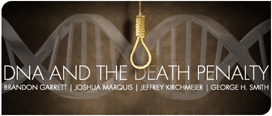As we seek ways to limit the number of innocent defendants sentenced to death, lawyers have suggested a number of ideas to help us get closer to certainty. Two areas that have come up in our discussion are the problems with confessions and with eyewitness identifications, but there are other problems as well.
Prof. Brandon Garrett and others have done important research about inaccurate eyewitness identifications.[1] A number of studies support a sequential identification process—where witnesses evaluate suspects one at a time instead of comparing possible suspects standing next to each other. Many advocate for police to use “double-blind” lineups, in which the person administering the lineup does not know which person is the suspect, thus avoiding any unconscious clues that the administrator might give to the witness. When Illinois and other states did exhaustive studies on practices that can lead to erroneous convictions, their reports made various recommendations, including double-blind and sequential lineups.[2] Joshua Marquis notes that there is ongoing research in the area about the use of sequential lineups in practice. But it is clear that while recognizing the realities and practicalities of police practices, the area of eyewitness identification needs some type of reform.
Other common suggestions include videotaping confessions, creating special evidentiary rules for informant testimony, and providing independent review of scientific evidence used in capital cases. For example, last year California passed a law preventing convictions based solely on informant testimony. I commend Marquis’s work in helping increase the use of recorded confessions and agree with him that it is an excellent idea to give law enforcement positive incentives for following best practices. Still, legislators and judges also have a responsibility to enforce practices if they are essential for accuracy, fairness, and due process.
While DNA evidence helps illustrate the problem of wrongful convictions, science currently cannot solve the problem of wrongful convictions or get us to a place of legal certainty as referenced by George Smith. Mistakes and improper use of forensic evidence itself has contributed to some wrongful convictions. A recent report by the National Academy of Sciences noted problems in the use of forensic evidence and suggested a number of reforms.[3] Still, it is a good start to learn what we can from science, as long as we are using good science. Regarding the advocates for a broad collection of DNA evidence and Marquis’s suggestion that the government might need my DNA because I am a lawyer, I will leave that issue for another discussion, except to say that others have raised concerns both about privacy and overburdening DNA labs.
While the scientific evidence and studies on confessions and identifications may help us understand how conviction errors occur, such information still does not help us establish a science of distinguishing those properly sentenced to life in prison from those properly sentenced to death. George Smith discussed the moral debate on capital punishment among philosophers like Immanuel Kant and Jeremy Bentham. Interestingly, I suspect that neither would change their position on the use of the death penalty in light of DNA exonerations. Kant was certain that there was an unquestionable duty to kill murderers. I admire Kant’s confidence and certainty. But unlike Kant, I find it difficult to see certainty in convictions and death sentences, especially in light of the DNA exonerations. So I find myself aligned with Cesare Beccaria in seeing “that the history of mankind appears a vast sea of errors, among which there float a few confused truths.”[4] And in accepting our infallibility, we might want to be extra careful about using our government’s power to impose death.
Notes
[1] Brandon L. Garrett, “Judging Innocence,” 108 Colum. L. Rev. 55 (2008).
[2] Report of the Illinois Governor’s Commission on Capital Punishment (2002).
[3] Nat’l Research Council, Nat’l Acad. of Scis., Strengthening Forensic Science in the United States: A Path Forward (2009). See also Paul C. Giannelli, “Forensic Science Reform,” 90 Tex. L. Rev. 29 (2011).
[4] Cesare Beccaria, Of Crimes and Punishments 60 (New York: Marsilio Publishers 1996).

